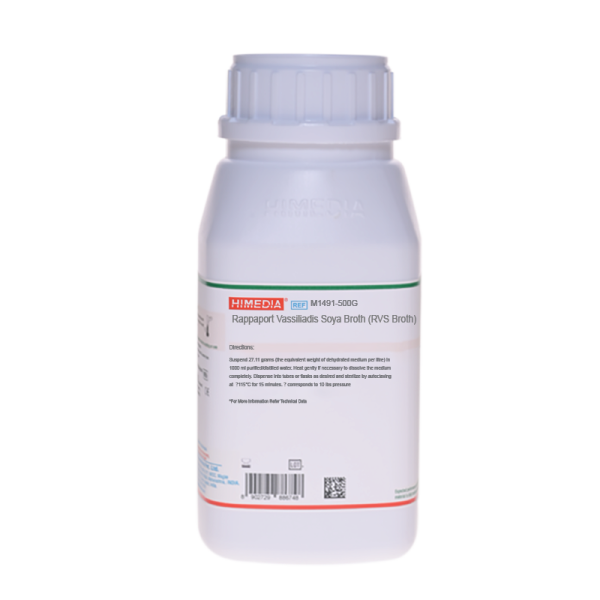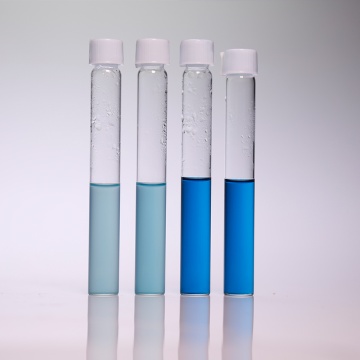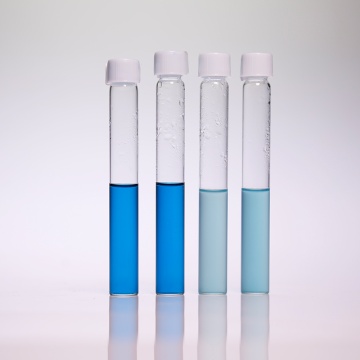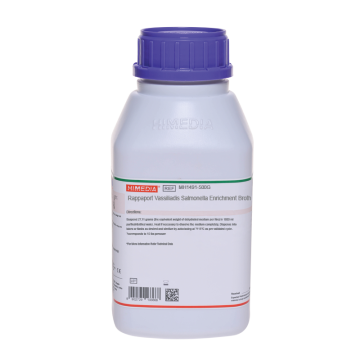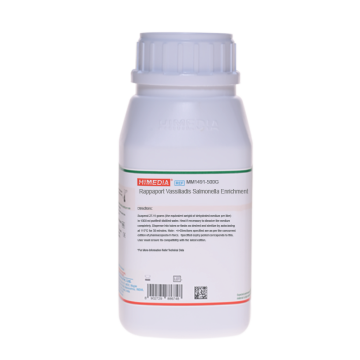 Your enquiry has been submitted
Your enquiry has been submitted
Rappaport Vassiliadis Soya Broth (RVS Broth)
Intended Use
Selective enrichment medium for Salmonellae species from food and animal feeding stuffs and clinical specimens.
Composition**
| Ingredients | g / L |
|---|---|
| Soya peptone | 4.500 |
| Sodium chloride | 8.000 |
| Potassium dihydrogen phosphate | 0.600 |
| Dipotassium hydrogen phosphate | 0.400 |
| Magnesium chloride hexahydrate | 29.000 |
| Malachite green | 0.036 |
Final pH ( at 25°C) 5.2±0.2
**Formula adjusted, standardized to suit performance parameters
Directions
Suspend 27.11 grams (the equivalent weight of dehydrated medium per liter) in 1000 ml purified / distilled water. Heat if necessary to dissolve the medium completely. Dispense into tubes or flasks as desired. Sterilize by autoclaving at 115°C for 15 mins.
Principle And Interpretation
Rappaport Vassiliadis Soya Broth is designed according to the revised formulation by Van Schothorst et al (1) and is recommended for the selective enrichment of Salmonellae from pharmaceutical products. This medium can also be used in direct enrichment of samples containing low inoculum. Present medium is a modification of the Rappaport Vassiliadis Enrichment Broth described by Van Schothorst and Renauld (2). Addition of magnesium chloride to the medium was reported by Peterz et al (3). Salmonella species can be isolated from human faeces without pre-enrichment by using this medium.
Salmonella generally survive at little high osmotic pressure, grow at slightly low pH and are resistant to malachite green compared to other bacteria. These characteristics are exploited in this medium for selective enrichment of Salmonella. Magnesium chloride present in the medium raises the osmotic pressure. Natural sugars of Papaic digest of soyabean meal provide essential growth nutrients and enhance the growth of Salmonella (4). Phosphate buffers the medium to maintain constant pH. Sodium chloride maintains the osmotic balance. Malachite green inhibits many gram-positive bacteria, while selectively enrich Salmonella. The relatively lower concentration of nutrition, also aids selective enrichment of Salmonella. This medium was reported to be superior to Salmonella selective medium like Tetrathionate Broth and Selenite enrichment broth and to Tetrathionate-Brilliant Green Broth for the detection of Salmonella in milk samples. The enriched culture of Rappaport Vasiliadis Soya Broth (M1491) can be further subcultured and isolated on Brilliant Green Agar (M016) or Deoxycholate Citrate Agar (M065), Xylose Lysine Deoxycholate Agar (M031).
Type of specimen
Clinical samples - faeces; Food samples and animal feeding stuffs.
Specimen Collection and Handling
For clinical samples follow appropriate techniques for handling specimens as per established guidelines (5,6). For food and dairy samples, follow appropriate techniques for sample collection and processing as per guidelines (7,8). After use, contaminated materials must be sterilized by autoclaving before discarding.
Warning and Precautions
In Vitro diagnostic use . For professional use only. Read the label before opening the container. Wear protective gloves/ protective clothing/eye protection/face protection. Follow good microbiological lab practices while handling specimens and culture. Standard precautions as per established guidelines should be followed while handling clinical specimens. Safety guidelines may be referred in individual safety data sheets.
Limitations
- This medium contains inhibitory substances and may not support the growth of certain Salmonella species like S. Typhi.
- Less selective enrichment broth must be used in conjunction.
- After enrichment the organisms must be isolated on less selective media along with selective media.
- Further biochemical and serological testing must be carried out for confirmation.
Performance and Evaluation
Performance of the medium is expected when used as per the direction on the label within the expiry period when stored at recommended temperature.
Quality Control
Appearance Light yellow to light blue homogeneous free flowing powder.
Colour and Clarity of prepared medium Greenish blue clear to slightly opalescent with a slight precipitate.
Reaction Reaction of 2.77% w/v aqueous solution at 25°C. pH : 5.2±0.2
pH 5.00-5.40
Cultural Response Cultural response was observed after an incubation at 30-35°C for 18-24 hours Recovery is carried out using Xylose Lysine Deoxycholate Agar (M031) after enrichment.
| Organism | Inoculum (CFU) | Growth | Recovery | Colour of colony |
|---|---|---|---|---|
| E.coli +S.Typhimurium (mixed culture) | ||||
| E.coli | 50 -100 | none-poor | <=10 % | yellow |
| S.Typhimurium | 50 -100 | luxuriant | >=50 % | red with black centers |
| Staphylococcus aureus subsp. aureus ATCC 25923 (00034*) | >=10⁴ | inhibited | 0% | |
| Enterococcus faecalis ATCC 29212 (00087*) | >=10⁴ | inhibited | 0% | |
| Salmonella Abony NCTC 6017 (00029*) | 50-100 | luxuriant | >=70 % | red with black centers |
| Salmonella Typhimurium subsp. aureus ATCC 14028 (00031*) | 50-100 | luxuriant | >=70 % | red with black centers |
| Staphylococcus aureus ATCC 6538 (00032*) | >=10⁴ | inhibited | 0% | |
| Escherichia coli ATCC 25922 (00013*) | 50 -100 | none-poor | 0 -10% | yellow |
| Salmonella Enteritidis ATCC 13076 (00030*) | 50-100 | luxuriant | >=70 % | red with black centre |
| Escherichia coli ATCC 8739 (00012*) | 50-100 | none-poor | <=10 % | yellow |
| Salmonella Paratyphi B ATCC 8759 | 50-100 | luxuriant | >=70 % | red with black centre |
Key : *Corresponding WDCM numbers.
Storage and Shelf Life
Store below 10-30°C in a tightly closed container and the prepared medium at 15-30°C. Use before expiry date on the label. On opening, product should be properly stored dry, after tightly capping the bottle in-order to prevent lump formation due to the hygroscopic nature of the product. Improper storage of the product may lead to lump formation. Store in dry ventilated area protected from extremes of temperature and sources of ignition Seal the container tightly after use. Product performance is best if used within stated expiry period.
Disposal
User must ensure safe disposal by autoclaving and/or incineration of used or unusable preparations of this product. Follow established laboratory procedures in disposing of infectious materials and material that comes into contact with clinical sample must be decontaminated and disposed of in accordance with current laboratory techniques (5,6).
Reference
- Van Schothorst M., Renauld A. and VanBeek C., 1987, Food Microbiol., 4:11.
- Van Schothorst M. and Renauld A., 1983, J. Appl. Bact., 54:209.
- Peterz M., Wiberg C. and Norberg P., 1989, J. Appl. Bact., 66:523
- McGibbon L., Quail E. and Fricker C.R. 1984, Inter. J. Food Microbiol. 1:171.
- Isenberg, H.D. Clinical Microbiology Procedures Handbook 2nd Edition.
- Jorgensen, J.H., Pfaller, M.A., Carroll, K.C.,Funke., Landry, M.L., Richter, S.S and Warnock., D.W. (2015) Manual of Clinical Microbiology, 11th Edition. Vol. 1.
- Salfinger Y., and Tortorello M.L. Fifth (Ed.), 2015, Compendium of Methods for the Microbiological Examination of Foods, 5th Ed., American Public Health Association, Washington, D.C.
- Wehr H. M. and Frank J. H., 2004, Standard Methods for the Microbiological Examination of Dairy Products, 17th Ed.,APHA Inc., Washington, D.C.
| Product Name | Rappaport Vassiliadis Soya Broth (RVS Broth) |
|---|---|
| SKU | M1491 |
| Product Type | Regular |
| Physical Form | Powder |
| Origin | Animal Free (Veg) |
| Packaging type | HDPE |
| References | 1.Van Schothorst M., Renauld A. and VanBeek C., 1987, Food Microbiol., 4: |
| Customized Product Available | No |



